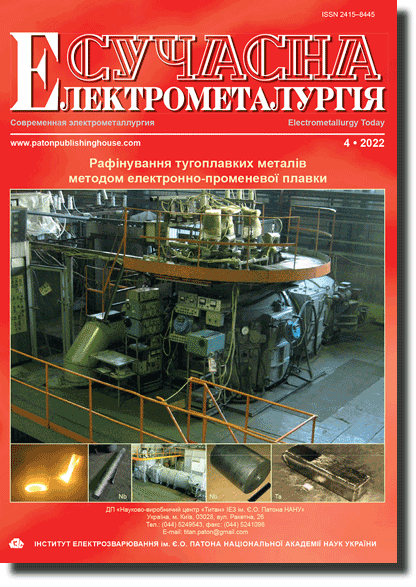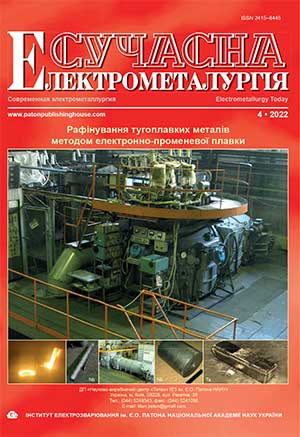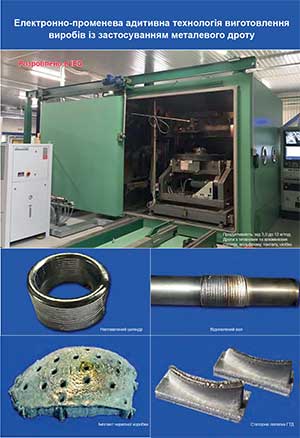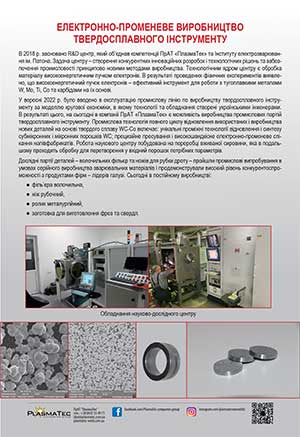| 2022 №04 (07) |
DOI of Article 10.37434/sem2022.04.08 |
2022 №04 (01) |
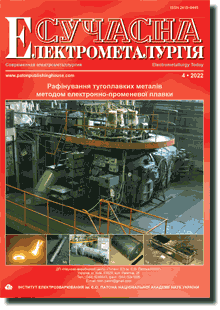
"Suchasna Elektrometallurgiya" (Electrometallurgy Today), 2022, #4, 49-56 pages
Exploration of the obtaining process of fluorophlogopite melt by electric arc melting for the production of massive cast corrosion-resistant products for non-ferrous metallurgy
V.M. Korzhyk1, V.O. Shcheretskyi2, A.G. Maliavin3, Yi Jianglong1, A.O. Aloshyn4, A.A. Aloshyn4
1China-Ukraine Institute of Welding, Guangdong Academy of Sciences, Guangdong Provincial Key Laboratory of Advanced Welding Technology. 510650, Guangzhou, China. E-mail: patonjournal@gwi.gd.cn
2E.O. Paton Electric Welding Institute of the NAS of Ukraine. 11 Kazymyr Malevych Str., 03150, Kyiv, Ukraine. E-mail: office@paton.kiev.ua
3Physico-Technological Institute of Metals and Alloys of the NAS of Ukraine. 34/1 Vernadskyi Blvd., 03142, Kyiv, Ukraine. Е-mail: metal@ptima.kiev.ua
4«Foreign Trade office of the Chinese-Ukrainian E.O. Paton Institute of Welding» Ltd. 11 Kazymyr Malevych Str., 03150, Kyiv, Ukraine. Е-mail: an_alex@i.ua
Abstract
The work reveals the issues of electric arc melting of non-metallic systems, such as oxide melts, for synthesis and casting of fluorophlogopite products, which are used as corrosion-resistant hydro- and gas-tight products for conditions of elevated temperatures and aggressive effects of chlorine, ammonia, metal melts, etc. The advantages and disadvantages of arc melting furnaces with a water-cooled crucible and graphite lining in the preparation of fluorosilicate melts are revealed. The effect of melting parameters and furnace design on the structure and phase composition of fluorophlogopite casting was investigated. The rational temperature regimes for obtaining fluorophlogopite melt were developed to minimize energy consumption and loss of volatile components from the melt. The effectiveness of technological sample application for express analysis of the fluorophlogopite casting quality is shown, which allows quickly correcting the charge composition by analyzing the technological sample fracture. This also allows using recycled material as raw material in the amounts of up to 50…60 %, in addition to mineral charge components. The proposed technological and design solutions allow obtaining fluorophlogopite melt in the amount sufficient for the production of massive castings over 150 kg. Ref. 5, Tabl. 1, Fig. 5.
Keywords: electric arc melting; fluorophlogopite; stone casting; express analysis; technological sample
Received 28.02.2022
References
1. Lejzerzon, M.S. (1962) Synthetic mica. Moscow, Gosenergoizdat [in Russian].2. Belyakova, Yu.A., Golenko, V.P., Gorbunov, L.V. et al. (1987) Synthesis of minarals. Vol. 2. Moscow, Nedra [in Russian].
3. Paton, B.E., Zabarilo, O.S., Ubel, V.G. (1956) Application of water-cooled metallic chill molds for flux melting in electric furnaces. Avtomatich. Svarka, 1, 65–69 [in Russian].
4. Platonov, G.F. (1965) Parameters and electric modes of metallurgical electrode furnaces. Moscow, Energiya [in Russian].
5. Nikolaev, N.S., Suvorova, S.N., Gurovich, E.I. et al. (1970) Analytical chemistry of fluorine. Moscow, Nauka [in Russian].
Advertising in this issue:
The cost of subscription/purchase order journals or individual articles
| Journal/Currency | Annual Set | 1 issue printed |
1 issue |
one article |
| TPWJ/USD | 384 $ | 32 $ | 26 $ | 13 $ |
| TPWJ/EUR | 348 € | 29 € | 24 € | 12 € |
| TPWJ/UAH | 7200 UAH | 600 UAH | 600 UAH | 280 UAH |
| AS/UAH | 1800 UAH | 300 UAH | 300 UAH | 150 UAH |
| AS/USD | 192 $ | 32 $ | 26 $ | 13 $ |
| AS/EUR | 180 € | 30 € | 25 € | 12 € |
| SEM/UAH | 1200 UAH | 300 UAH | 300 UAH | 150 UAH |
| SEM/USD | 128 $ | 32 $ | 26 $ | 13 $ |
| SEM/EUR | 120 € | 30 € | 25 € | 12 € |
| TDNK/UAH | 1200 UAH | 300 UAH | 300 UAH | 150 UAH |
| TDNK/USD | 128 $ | 32 $ | 26 $ | 13 $ |
| TDNK/EUR | 120 € | 30 € | 25 € | 15 € |
AS = «Automatic Welding» - 6 issues per year;
TPWJ = «PATON WELDING JOURNAL» - 12 issues per year;
SEM = «Electrometallurgy Today» - 4 issues per year;
TDNK = «Technical Diagnostics and Non-Destructive Testing» - 4 issues per year.





